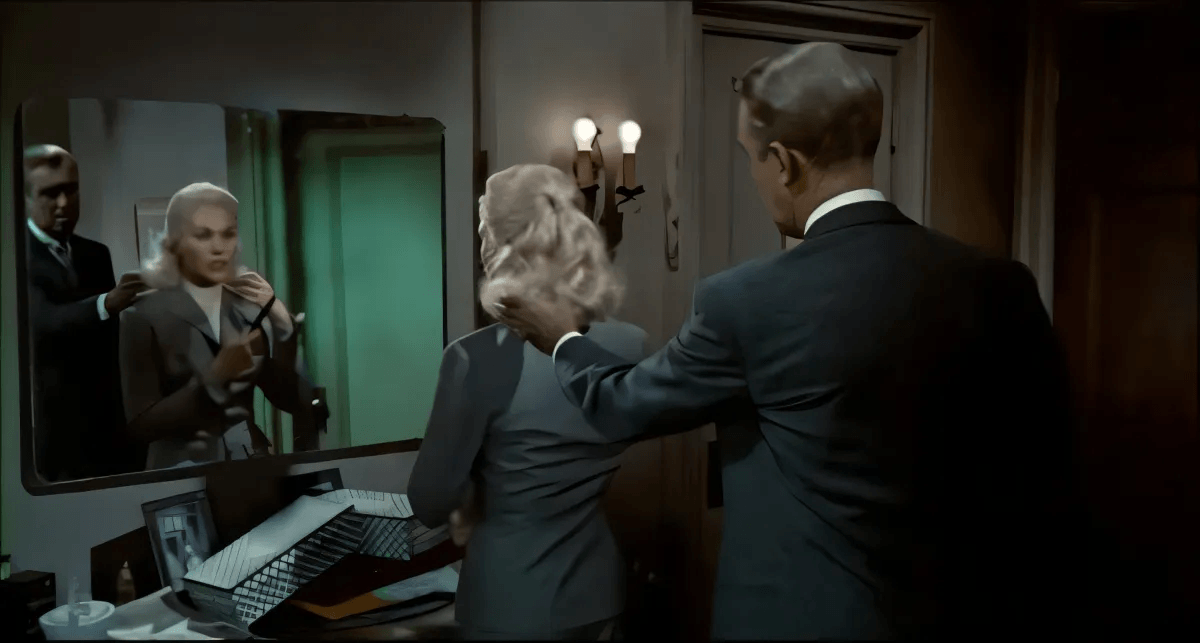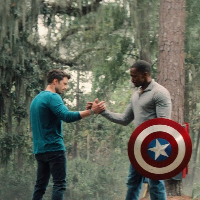Male Gaze In Cinema: Giving Vertigo To Viewers?
The male gaze has been overly present in cinema since its beginning. Even as the progression of feminism has grown rampantly over the years, the male gaze has remained constant in a majority of films.
The male gaze is, in cinema, a way of viewing and portraying women as sexual objects from a cis, heterosexual man's point of view.
Why are male characters the default?
Most films, historically, have been made entirely by men. When writing a story, it is common to have your main character reflect upon the identity of the author, resulting in an overrepresentation of men as the main characters.
Typically, a female character has to be purposefully included in a narrative, which slows and can even work against a storyline’s development. This works against feminist ideals and slows the progression of equality between genders.
Vertigo (1958): A main culprit of the male gaze

Movies like Vertigo are classic examples of conforming to the male gaze in cinema. The main character, Scottie, is portrayed as a level-headed and manipulative man who is presented with issues coming from the women in his life.
On the other hand, his ex-wife is solely portrayed as similar to an obsessive, and sometimes crazy, mother. Meanwhile, his love interest Madeleine is purposed as a beautiful and mysterious, albeit also crazy, the woman whose personality centers solely on her looks.
Although the male gaze is somewhat used to distract the audience from her manipulation of Scottie, it also emphasizes the only way to be able to influence a man is by flaunting her looks. This focus on the appearance of women not only hinders the progression of the plotline but also the deliverance of the message altogether.
The fact that the part of the film with Madeleine as the central love interest takes up a majority of the film, despite the part with Judy being actually responsible for delivering the theme, hinders the continuation of the plot and the theme.
Scottie’s overall obsession with Madeleine and her looks—representative of the male gaze—is essentially the entire plotline with little focus on his previous relationship or even him as a character.
The objectification of women throughout this film not only negatively impacts the film’s message and character development but also contributes negatively to society.
Although the film was still a major success and was groundbreaking in its film techniques, the film itself introduced a semi-new genre of film but unfortunately started the genre off by objectifying women and establishing a pattern that still lasts in many films today.
What does a movie without the male gaze look like?

In cinema, the male gaze has become a hindrance to the continuation of a plotline and development of the overall theme but films like Fargo, which eliminate the male gaze, still prove equally as successful in the box office and more successful in plot development and thematic impact.
Contrary to the pattern Hitchcock established, films like Fargo forego the male gaze altogether and focus on the power women can have when they are made the main character without it being overwhelmingly feminist.
A problem many films have when they move past the male gaze is to make their female characters seem exceptionally masculine and try to hide the feminine aspects of the character altogether.
One of the central characters in Fargo is Sheriff Marge Gunderson, who is adept at solving crimes in the small town of Brainerd, Minnesota. Although she may be thought to be masculine within her job choice, her behaviors combined with the fact that she is pregnant negate making her either too feminine or masculine.
Within the gender, binary is also a binary within men and women. For females, the binary is between maternal and non-maternal women, with non-maternal women deemed as a sort of false woman.
By becoming the ‘elite’ of womankind by bearing a child and also being the highest-ranked within a male-dominated profession, Marge is balancing the roles of hyper-masculine and hyper-feminine without leaning too strongly toward one or the other.
The male main characters of the film also showcase the overly masculine side of the masculine binary between being an individual and being a follower. There are only two male characters that act as individuals, while the rest would be deemed ‘followers’.
Jerry Lundergaard’s father-in-law, who is the rich man Jerry is trying to get money from by hiring two men to kidnap his wife, would be considered an individual and so would Carl Showalter, the main man he hires to kidnap his wife. Carl ends up shooting Jerry’s father-in-law, but he also eventually gets caught by Sheriff Gunderson.
This goes to show that Marge would be considered the ‘alpha male’ of the film, but she is also considered the ultimate woman by being pregnant. This dichotomy represents strength in the main female character and weakness in the male characters.
Throughout the film, there were only six women who had speaking roles within the film. Although this may seem like an anti-feminist thing for Coen to do, it seemed to only capitalize on the fact that the male gaze was absent throughout.
The majority of the men in this film did not act nearly as level-headed or intelligently as the women did, making the women’s roles seem more important to the continuation of the plot as a whole.
The six women who had speaking roles include Marge, Jean Lundergaard, a TV news reporter, and three who worked in the sex industry. Although those three women worked in a sex-related field, the characters themselves didn’t appear to be sexualized. They are seen in moderate clothing for their profession and none of the female characters appear to be wearing makeup to the point where it is noticeable for the character and not just for the camera.
By representing the women as people essential to the plot without overly focusing on their sexuality, Coen is successfully continuing the movement of the plot and the deliverance of the movie’s message.
This message is taught from the experiences of the male characters, namely Jerry and Carl. They show the consequences of selfishness and how it impacts the people around them.
Most of the people Jerry cares about end up dead, even though he just planned to hire somebody to kidnap his wife so he could collect half of the ransom money from her father. Carl, being the person hired, focused solely on the reward no matter the cost of killing the people who got in his way.
Eliminating the male gaze means more effective storytelling
The theme of Fargo is much more apparent than that of Vertigo, where the male gaze was extremely present and overwhelming to the plot. These two films are examples of how the male gaze hinders a movie’s meaning and mostly serves as a distraction when female characters could actually be useful toward the plot.
By deleting the male gaze from films altogether and instead utilizing female characters similarly to male characters, as productive members of a plotline, filmmakers can be more successful and their films can be more accurate and reflective of society.
When films like Fargo eliminate the male gaze, they will continue to be successful at the box office and even more successful in plot development and thematic impact in comparison to films like Vertigo which rely solely on the male gaze.
What makes a movie feminist?
The male gaze is proven to be detrimental to women's self-esteem, which can have long-term effects. When films finally rid of the male gaze, society can continue the trend and stop hyper-sexualizing women.
Eliminating the male gaze makes a movie inherently more feminist, which broadens the amount of people who will enjoy a movie and make it more socially impactful.
Fargo is not the only example of a truly feminist movie without having a feminist agenda, but it is the most effective at displaying the power an "alpha male" female can have without the character being oversexualized.
When filmmakers start making movies without having an agenda but remain conscientious about the work they are creating for society, we will be one step closer to truly treating women equally to men.
Opinions and Perspectives
Reading this makes me want to create a watchlist of films that successfully avoid the male gaze.
It's amazing how much more engaging a story can be when characters aren't reduced to stereotypes.
I'm glad we're having these conversations about classic films while still appreciating their artistic merit.
The point about successful storytelling without agenda is crucial. Just write good characters, regardless of gender.
Looking at these two films side by side really shows how far we've come and how far we still have to go.
This kind of analysis has really changed how I watch and evaluate films.
Just realized how many films I love would fail these criteria. Maybe it's time to expand my viewing habits.
The way Fargo handles its female characters should be a template for modern filmmakers.
I appreciate how this analysis goes beyond just counting female characters to look at how they're actually portrayed.
Seems like we're finally starting to understand how the male gaze affects not just representation but storytelling quality too.
The article really helped me understand why some films feel more authentic than others in their character portrayals.
I find it powerful how Fargo shows strength in femininity without rejecting it.
It's interesting how removing the male gaze actually makes both male and female characters more complex.
The contrast between these two films really shows how storytelling can either be enhanced or hindered by the male gaze.
What's fascinating is how Fargo manages to critique masculinity without becoming preachy about it.
I'm struck by how Marge's pregnancy is just part of her character rather than her defining trait.
The article's analysis of how Fargo handles its female characters without making it a big deal is spot on.
This makes me wonder about how many female-directed films we've missed out on throughout cinema history.
Everyone talks about Vertigo's technical achievements, but we rarely discuss its problematic elements in film classes.
The success of both these films shows that audiences are capable of accepting different approaches to storytelling.
I work in film and sadly still see these issues playing out in modern productions.
The article's point about how the male gaze slows down storytelling is something I'd never considered before.
It's amazing how a film from 1996 still feels more progressive than many movies made today.
Modern filmmakers could learn a lot from Fargo's approach to character development.
The part about Marge being both the alpha and traditionally feminine is really insightful. Shows how roles don't have to be binary.
I actually think Vertigo was trying to critique obsessive male behavior, even if it fell into the same traps it was criticizing.
The comparison between these two films really shows how much more engaging a story can be when it focuses on character rather than appearance.
We need more films that treat women as complete human beings rather than just plot devices or eye candy.
Fascinating how Marge's character works because she's allowed to exist in multiple spaces without contradiction.
I appreciate how the article points out that fighting the male gaze doesn't mean making women masculine.
This really makes me think about how many great stories we've missed out on because of adherence to the male gaze.
Anyone else notice how the women in the sex industry in Fargo are treated as actual characters rather than just objects?
The success of Fargo proves audiences don't need female characters to be sexualized to be engaged in a story.
I've always found it ironic that Vertigo is considered one of the greatest films ever made, yet it's so problematic in its treatment of women.
It's worth noting that even Frances McDormand's appearance in Fargo isn't glamorized. She looks like a real person doing her job.
The article makes me want to rewatch both films with these perspectives in mind. I bet I'll notice so much more now.
That's exactly the kind of thinking that allows problematic portrayals to continue unchallenged in cinema.
Sometimes I wonder if we're overthinking this. Can't we just enjoy films for what they are?
What I find particularly interesting is how Fargo manages to be feminist without explicitly trying to be feminist.
The point about balancing maternal and professional roles in Fargo is spot on. It's rare to see that even in today's films.
Interesting analysis, but I think we're sometimes too quick to condemn older films through a modern lens.
I never realized how much Scottie's obsession with Madeleine's looks actually detracts from the thriller aspects of Vertigo.
Something that struck me was how Marge's pregnancy in Fargo isn't used as a plot device or weakness. It's just part of who she is.
The comparison between Vertigo and Fargo really highlights how the male gaze can actually harm storytelling. Vertigo's plot gets lost in its obsession with Madeleine's appearance.
I strongly disagree with the previous comment. We've made huge strides in female representation. Just look at recent films by women directors.
Let's be honest though, modern movies aren't much better. We've just gotten more subtle about the male gaze.
The part about only six women having speaking roles in Fargo is interesting. It shows you don't need a large quantity of female characters if the ones you have are well-written.
I never thought about how Jerry and Carl's portrayal in Fargo actually subverts traditional masculine roles. The men are the ones making emotional, irrational decisions while Marge stays cool and logical.
While I agree the male gaze is problematic, I think we need to consider the historical context of films like Vertigo. It's a product of its time, even if that doesn't excuse it.
You make a great point about Fargo. I love how Marge's pregnancy isn't treated as a weakness but actually adds to her character's complexity.
I've always found it fascinating how Vertigo, despite being a masterpiece of technical filmmaking, really does exemplify the male gaze problem in classic cinema. The way Madeleine is portrayed is almost uncomfortable to watch now.
